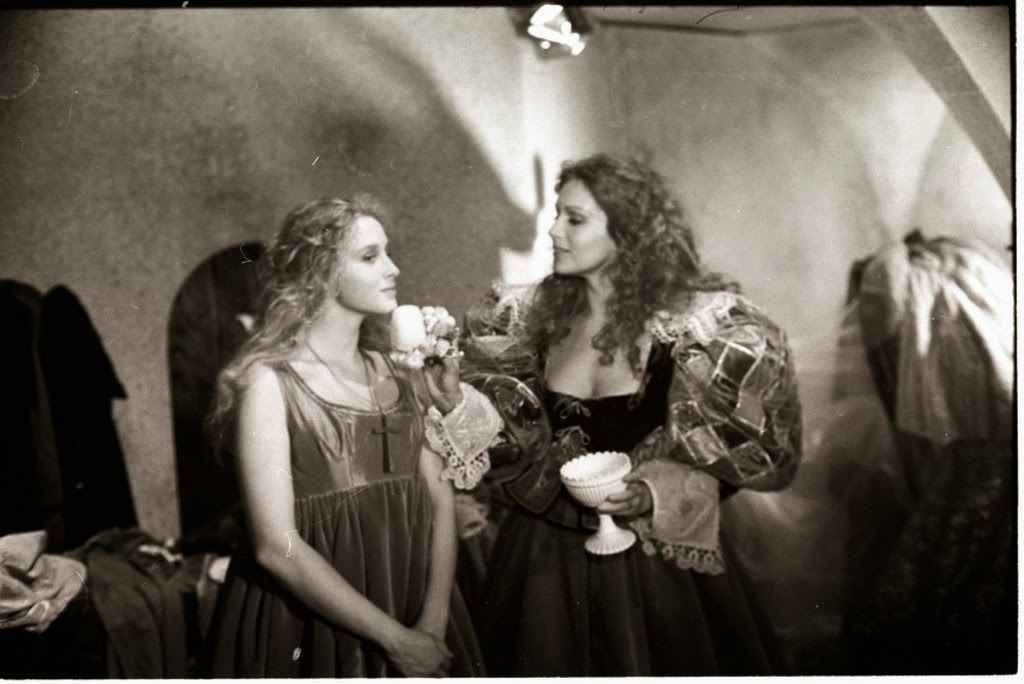Spanish Poster
Los pajaros de Baden-Baden, a Spanish production directed by Mario Camus, tells the story of a graduate student, Elisa (Catherine Spaak), who remains behind in Madrid while her parents are away on vacation for the summer. Elisa is working on a book for her thesis, which is to be published, and her professor sends her to a photographer to procure pictures to illustrate the book. The photographer, Pablo (Frederic de Pasquele), is a former professor and journalist, among other professions, all of which he has failed at. Elisa is intrigued by the intelligent, but melancholy and lost Pablo, who lives alone in a modest abode with his son. His wife left them, because she could no longer deal with Pablo's problems, and the son goes to visit her on occasion. We are left with the impression that the son, who is about 12, feels a duty to stay with his father and try to help him, or at least look after him.
Elisa comes from a wealthy family and has a young and wealthy boyfriend who is neglecting her, making excuses of being busy pursuing business opportunities with others. That neglect contributes to her interest in the 40-ish Pablo, who is so different from the crowd with which she normally socializes. It is not clear whether she is attracted to Pablo because he is so different from the other men in her life or because she sees him as someone that she should try to "fix." Regardless of the reason, they pursue a sexual affair for the summer and express their love for one another, but ultimately their different states in life break them apart. By the time that Elisa decides that she does not care about their differences and just wants to try to make a go of it with Pablo, it is too late.
The film is based on a short story and gets its title from a Spanish saying, which claims that Madrid in the summer, without family and money in your pocket, is a 'Baden-Baden.' Since I am not Spanish, I do not really understand that saying, but that is the story behind the title of the film.
Los pajaros de Baden-Baden has a lot of positives going for it. Catherine gives what I think is one of the best dramatic performances of her career, the cinematography and technical work are good (with good location scenes around Madrid), the musical score is good for the mood of the film, the film gives a good sense of a hot Madrid summer, and Pasquele is very good as Pablo. Catherine is lovely as usual, with the long strawberry-blondish hairstyle that she had been wearing for a couple of years. In fact, as she walked across the screen, I was reminded of lyrics from the classic song Girl from Ipanema: "Tall and tan and young and lovely..." 29-year-old Catherine looked thinner than she had over the last few years. That is neither a positive nor negative comment, just an observation. I tend to pay attention to that, because I have seen comments from her, in interviews done later in life, that she had some issues with anorexia through the years. She does not look unhealthy in this film, just thinner than she had looked recently.
Despite those positives, the film is not great, and it is not a classic. It is a "pretty good" film that somehow just comes up a bit short. I think that is the result of a story/script that is not very compelling, combined with a melancholy storyline and sad ending. In some respects, I suppose that La noia could have had some of the same things said about it by some viewers, but I found that story more compelling and the ending more satisfying. I loved La noia. I can see why Catherine would have been attracted to the project. It seemed like a stronger role for her than in some of her recent films and was likely one in which producers were optimistic about awards. If given a U.S. content rating today, it would likely be a fairly mild PG-13 (close to a PG).
Overall, I would recommend that all Catherine Spaak fans make the effort to seek out Los pajaros de Baden-Baden. Catherine is in almost every scene of the film, giving a strong dramatic performance, in what is a "pretty good," though not great, film. As a bonus, you get some cool shots of Madrid in 1974.
Lensed in Madrid, Spain in the fall of 1974 (with final production completed by February 1975), Los pajaros de Baden-Baden premiered in Madrid on May 2, 1975 (per IMDB).
- The September 18, 1974 Variety reported from Madrid: "Also currently rolling is Impala production of 'The Birds of Baden-Baden.' Mario Camus directs. Catherine Spaak and Frederick de Pasquale topline."
- The January 29, 1975 Variety reported: "'Birds of Baden- Baden,' a Catherine Spaak, Frederick de Pasquale starrer due to be in can in a few weeks.'
It appears that the state-run film industry in Spain saw the film as an artistic success that it hoped would receive critical acclaim internationally. The film, along with other Spanish productions, was not accepted at Cannes in 1975, which upset the producers. The film, though only a modest performer at the Spanish box office, was well-thought-of enough to be awarded a Second Prize at the Spanish Entertainment Syndicate gala dinner on January 31, 1976. The film was promoted through notices in Variety into 1976, along with a report that the Spanish government intended to push the film into Latin American markets in 1976. Efforts to promote the film outside of Spain must have had little success. I have found very little promotional material for the film, with the only item outside of Spain being the Argentinian comic shown below.
- The May 7, 1975 Variety reported that Spanish producers were upset at the way that Spanish films had been dismissed in April on a cursory basis from acceptance for Cannes. Included among the films viewed and rejected was Baden-Baden.
- The film won Second Prize from the Spanish Entertainment Syndicate at a gala dinner on January 31, 1976 (per the February 11, 1976 issue of Variety).
- The March 31, 1976 Variety reported that the film was one of a handful of films that the Spanish government intended to push in the Latin American market in 1976.
- The September 8, 1976 Variety, in regard to director Camus, reported: "Camus has lately improved his scope with "The Wind's Anger" and especially' his latest (1975) pic, 'The Birds of Baden Baden' where he shows his mettle when working with a solid script and good thesps".
During the effort to continue pushing the film into 1976, it received a positive review in the February 25, 1976 issue of Variety, based on a February 13, 1976 viewing at Cine Fatasio in Madrid (with a running time of 106 minutes). [Note: The version that I viewed ran about 102 minutes.] The review states in part:
"Title here can be confusing, since item has nothing to do either with birds or Baden-Baden. The old German spa crops up only because of a Spanish saying which claims that Madrid in the summer, without family and money in your pocket, is a 'Baden-Baden.' ...
The Birds of Baden-Baden is a beautifully-made film which nicely captures some of the subtler realities of Spain. A merely allright scripture is helped by the sensitive, stellar performances of Catherine Spaak and Frederic de Pasquale who transform it into a really touching tour de force. Though both are non-Spanish thesps, their performances are fully convincing as they enact their ill-fated love story. De Pasquale's excellent performance as the washed up intellectual and jack of all trades perfectly matches Spaak's touching portrayal of a scion of the mindless affluent class who discovers a new dimension in Pablo's shattered world.
...
Item is a well-told love story which might get additional mileage due to the Spaak and De Pasquale billing. In Madrid it had a middling run. It also cupped several Syndicate awards as one of Spain's best pix of 1975."
Though I had long thought that this film would be among the few Spaak films that I would never be able to see, it surfaced in Spain on DVD as part of a boxed set of Mario Camus films.
As mentioned above, I have had very little luck in locating publicity material for the film. Other than the Spanish poster at the top of this post, the only other items that I have found are shown below.
A still photo:
A Spanish lobby card set:
An Argentinian comic:



.jpg)
































































































